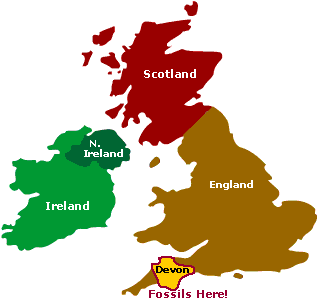|
Names on the Staircase
of Time
The odd names of the different time periods
on the Staircase of Time were made up
by geologists, who were the first people
really interested in finding out the actual
age of the Earth. Most of the names have
to do with places where certain types
of fossils were found.
Fossils! The word "fossil"
means "things dug up," but now we usually use it to refer
to any evidence of past life buried in the ground. It is by studying
fossils that we first began to discover how much really happened
on good old Mother Earth. Fossils are found in many places on the
surface of Earth, but not all. Through careful study, we find that
certain types of fossils always occur together, and that these different
groups of fossils are always found in the same order where many
layers of rocks were visible (like on a mountain side or in a deep
mine). These groups of fossils show that different types of life
forms have lived on Earth at different times in its history. When
geologists first learned about the different fossil groups, they
named the different time periods after the locations where the fossils
were found. For example, the Devonian period was named for a group
of fossils found in the shire of Devon in England.

Of course, just like
we divide up the year into months, weeks, and days, geologists divide
the history of Earth into several different time periods. The longest
time period geologists use is called an "eon." Eons are
divided into shorter time periods called "eras," and eras
are divided into even shorter times called "periods."
There are even shorter periods of time called "epochs"
and "ages," but we won't worry about them! On the Staircase
of Time, the different colored sections of the staircase show
the different eras and the Precambrian Eon. The steps within the
Precambrian Eon represent different eras, while the remaining steps
represent different periods.
Back
| Next
|











